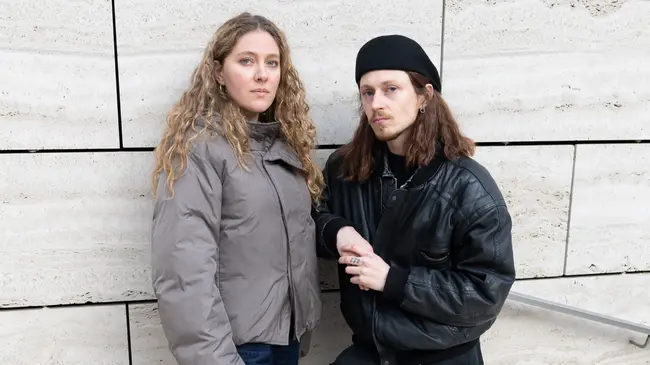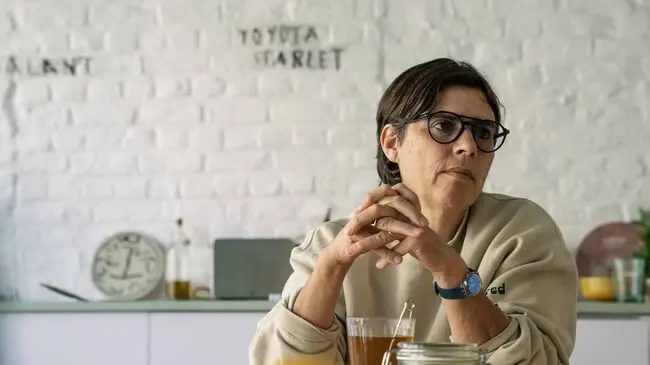A visitor is always curious about what is hidden

'Pretty as a picture' is a commonly used expression, but it could just as well be pretty as the back of a picture, proves the exhibition Twaalf in een Dozijn at Mu.ZEE. In collaboration with Mu.ZEE curator Ilse Roosens, conservator Barbara de Jong, NEIN-host Laurens Mariën and Twee-eiige drieling, artist Marlies De Clerck painted 12 interpretations on 12 backsides of paintings. Marlies gave us a tour around the exhibition while she shared her thoughts on authenticity and authorship, and what it’s like to represent the side of history that has always been hidden.
There are few things as captivating as standing in front of a painting and noticing all its details. But what is often forgotten is that the back of a painting is equally as intriguing. Stickers of past exhibitions, travel passports, notes from the painter or a curator: a complete history is going on behind our favourite canonical works.
How did the project come about? How did the collaboration between NEIN, Mu.ZEE and you happen?
Laurens Mariën, the host at NEIN, had the initial idea to do something with the backside of paintings. He approached Mu.ZEE-curator and art-historian Ilse Roosens for this project, who was immediately intrigued. The backside of a picture is never shown, although it holds a lot of information and history. A visitor is always curious about what is hidden. Both of them approached conservator Barbara de Jong and made a selection of 12 backsides of paintings of the Mu.ZEE collection. They wanted to reinterpret these backs, not just show them or show pictures of them. That’s where I come in.
When they asked me to paint these backsides, their first idea was to work with a ghost-painter, to keep the artist a secret. But it became very clear early on that the piece would always be characterized by my way of working, my style, and whatever sparks my interest. That’s when the real collaboration began. We stumbled on a lot of questions of authorship, in philosophical ways but also in legal matters. Whose work is it, if it’s an interpretation? Is it a pure copy? Where do we draw the line between being inspired by something and copying it?
The backside of a picture is never shown, although it holds a lot of information and history
Legally, the backside of a canvas is public property. It’s not only altered by the hand of the original artist, but it has stickers from past exhibitions on it, notes from the artist and the countries where it’s been. The backsides are not artistic choices but coincidences, practical notes and legal matters. You can see the whole route a painting has travelled to get where it is now.
How did the collaboration shape the exhibition?
I think the collaboration is truly what makes this exhibition so interesting. It raises questions about what we show in a museum and why the role of a museum is so important in how we preserve art. Mu.ZEE has over 8000 works in its collection, which of course can’t all be exhibited. But all of these works need a lot of professional attention. They frequently need to be restored and checked. The exhibition is giving credit to the role of preservation of a museum. Preserving our art and history is important to shape our critical thinking. We need to be able to make dialogue with our history. I think the collaboration also has a symbolic importance: the curator, the conservator, the art collective NEIN, the museum and even the jurists are all co-authors of this project. We also worked with Chloe D’hauwe, a fantastic graphic designer. She designed an amazing publication about the exposition, which is for sale in the shop, as well as a postcard-print of one of the paintings.
How did you start working on these paintings? Did you see the backs of the original works and interpret them?
I saw the works in real life, but only the backsides and not the actual paintings. Laurens, who chose the twelve pieces, made pictures of the backs and I worked with those pictures. But for example, the pictures were not of the greatest quality - that’s where a lot of personal imagination and interpretation comes in. I was relying on my memory of the pictures and the bad photos, which made the painting float somewhere between facts and imagination. It’s kind of a dialogue with the original artist but with a fat studio wall blocking clear communication.
Why didn’t you look at the front of these paintings?
I didn't want to. I wanted to search for the meaning of authorship and authenticity, what a museum means in an art-historical context and what a collection is. I didn’t want a one-on-one dialogue with the original artist: I wanted that conversation to happen indirectly, through a catalogued history.
It’s also not just my painting; it’s by everyone that collaborated in this exhibition. The whole is greater than the sum of its parts. For one painting I made, the last one, it is very unclear who is the author. The original artist had painted on the back of the picture as well. He probably decided it wasn’t any good and started working on the other side of his canvas. It raised the question of what it means if I re-painted that painting. Was that stealing? He had never shown it to the public, so could we even consider it as part of his oeuvre?
You’re intrigued by how a piece of art survives history. Is durability, or sustainability important in your work as well?
I want my work to survive time. Not as a symbolic or substantive choice, but really when it concerns what kind of materials make it to my canvas and in what way. I use qualitative paint that is resistant to UV, for example. I use good canvas and aluminium frames instead of wooden frames as they might bend with temperature. I want my work to be durable.
I want my work to survive time, to be durable
There are artists that get inspired by how their work changes throughout the years because of their choices of material. Other artists write on the back that you can not varnish the piece. I think all artists have an idea of how they want their work to move through history: static or dynamically, ever-changing, whatever. The way we use material, and which materials already tell a story. I think about the Greek statues a lot, and how they used to be in all these bright colours until someone decided to wash them. We now think of the Greek statues as a cream colour, and it’s hard to imagine they once had colours. In ways like that, how an artwork is conserved has a lot of impact on how it is perceived. So it should be the choice of the artist. Using these durable materials means it will not have to be restored that many times as avant-garde works for example.
How did this project shape your way of working?
I think I will take a lot of time to reflect on this project. I want to spend a lot of time in my atelier and just work on stuff. I used to work in series, but I might want to discover making more standalone pieces. Like my previous work, I think it will still be a take on Belgian culture and irony.
I used to work in series, but I might want to discover making more standalone pieces
There is also a table at the exhibition where visitors can draw their own interpretation of the front of one of your paintings. Your painting says ‘Elias, a tree for my son Sammy’, a sentence that certainly unlocks a fantasy. What were the interpretations by visitors on that painting?
It’s one of the backsides that really makes you wonder about the front. I’ve seen so many different takes on it. The principle is that visitors draw the front of the painting and then place it on the wall, on top of the other drawings. It’s a bit of a depository itself.
We wanted to keep the magic of wondering what the front of the painting would look like. The energy of surprise and curiosity is what makes this exhibition so special.
Different Class works with the interest of their community at heart.
Our work’s purpose is to foster a solid network for independent artists, those who love them, and those who want to support them. Become a member to contribute to the local Belgian art scene.





